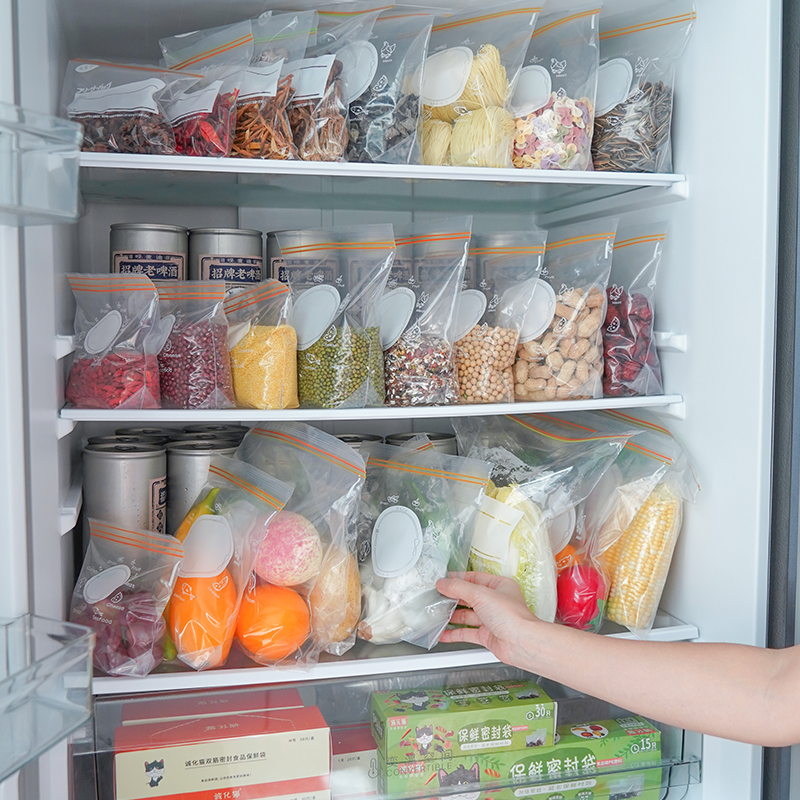The kitchen is one of the cores of family life. An organized kitchen not only improves cooking efficiency but also brings a pleasant mood. Ziplock bags, as a multifunctional storage tool, have become an essential helper for organizing the kitchen due to their convenience, durability, and environmental friendliness. This article will introduce how to use ziplock bags to organize your kitchen, helping you better manage food and space.
Classification and Storage
1. Dry Goods Classification
Using ziplock bags can easily classify and store various dry goods such as flour, rice, beans, etc. Divide the dry goods into ziplock bags and label them with names and dates, which makes them easy to find and prevents moisture.
2. Frozen Food
Ziplock bags are ideal for frozen food. By dividing meat, vegetables, and fruits into ziplock bags, you can save freezer space and prevent food from mixing flavors. Try to expel as much air as possible before freezing to help extend the shelf life of the food.
3. Snack Storage
Small ziplock bags are perfect for storing various snacks such as nuts, cookies, and candies. They are not only convenient to carry but also keep the snacks fresh and tasty.
Space Saving
Ziplock bags have excellent flexibility and sealing properties, which can be adjusted according to the volume of the contents, thereby saving space in the refrigerator and cabinets. Standing or laying ziplock bags in the fridge can effectively utilize every inch of space and avoid waste.
Keeping Fresh
The sealing design of ziplock bags can effectively isolate air and moisture, helping to keep food fresh. Whether it’s refrigerated vegetables or frozen meat, ziplock bags can extend the shelf life of food and reduce waste.
Convenience
1. Cooking Convenience
When preparing to cook, you can pre-cut ingredients and divide them into ziplock bags, making it very convenient to use directly during cooking. For marinated ingredients, you can put the seasonings and ingredients together in a ziplock bag and gently knead to distribute the seasonings evenly.
2. Easy Cleaning
Using ziplock bags to organize the kitchen can reduce the use of bowls and plates, reducing cleaning workload. After using ziplock bags, they can be washed and dried for reuse, which is both eco-friendly and time-saving.
Environmental Friendliness
More and more people are paying attention to environmental issues. Using reusable ziplock bags not only reduces the use of disposable plastic bags but also saves resources and protects the environment. Choosing high-quality PE ziplock bags allows for multiple uses, reducing waste.
Practical Tips
1. Labeling
Stick labels on ziplock bags to mark contents and dates for easy management and retrieval. Using waterproof labels and durable pens can prevent blurred handwriting.
2. Portion Control
Divide ingredients according to the amount needed for each use to avoid waste and make it convenient to use. For example, divide meat into portions needed for each meal before freezing, so you don’t need to thaw too much at once.
3. Creative Use
Besides storing food, ziplock bags can also be used to organize small items in the kitchen such as utensils, spice packets, and baking tools. Keeping the kitchen tidy and orderly improves space utilization.
Conclusion
Using ziplock bags to organize the kitchen can effectively classify and store food, save space, keep food fresh, provide cooking convenience, and be environmentally friendly. Through the practical tips above, you can easily manage your kitchen and enjoy a more efficient cooking experience. Try using ziplock bags in your own kitchen and experience the many benefits they bring!
Post time: Jul-15-2024






